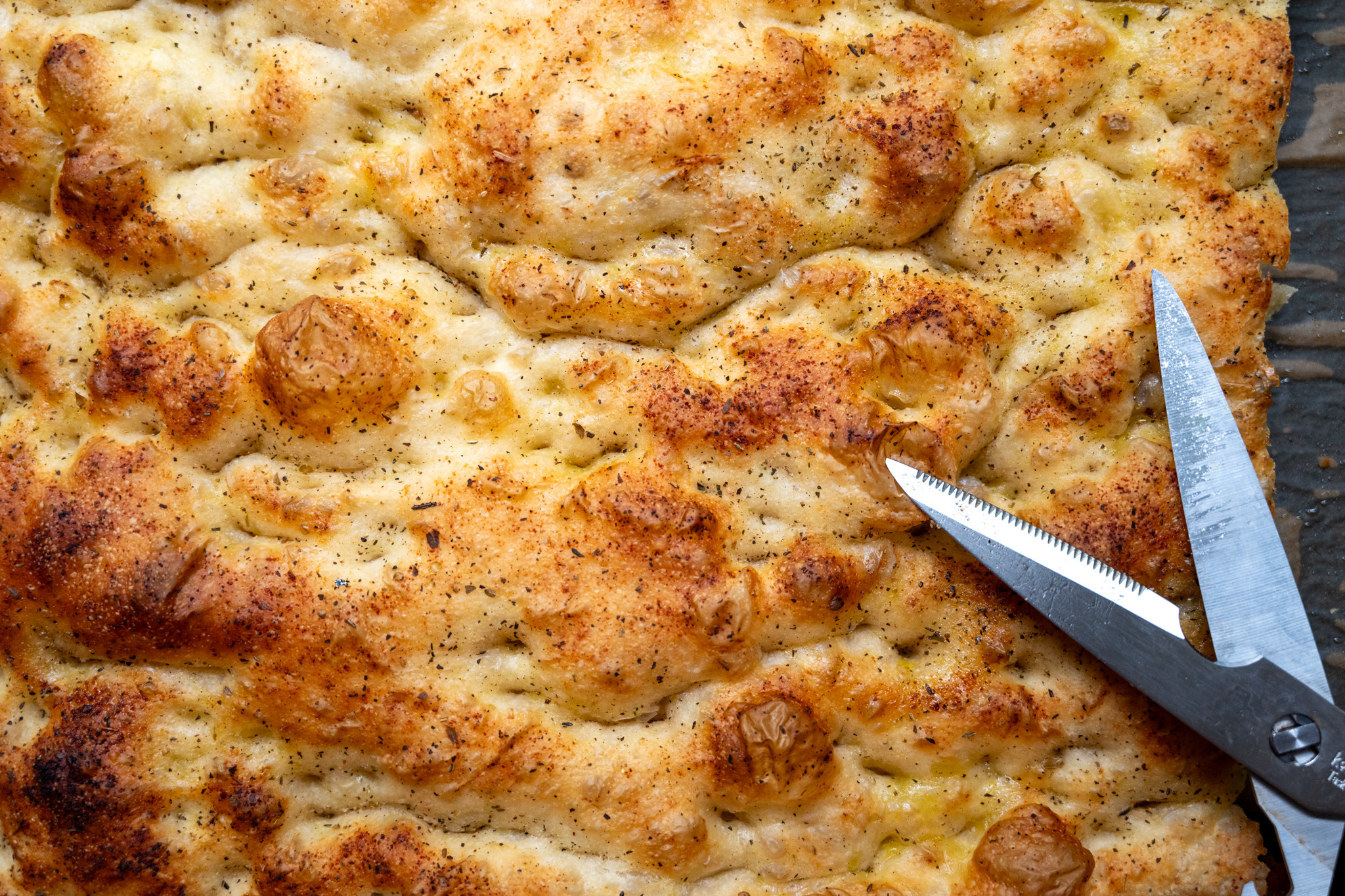This is pretty easy to get creative with. Just about any reasonable hard herb works really well. Think thyme, rosemary, or sage. Delicate herbs like basil will work, but they’ll be a little bit destroyed by the high heat of the oven.
Here in the US, most baking trays are made out of reflective silvery aluminum. These work for making something like a cookie, but less well here. If possible, you’re going to get better results — a lighter, airier crumb and a crispier bottom — using a dark steel baking tray. A cast iron pan can also work well.
Getting the amount of dough right for your pan matters a lot for a good focaccia. Too little dough for the pan, and you’re going to wind up with something very crisp without a fluffy center. Kind of like a cracker gone wrong. Too much, and you’ll run into obvious problems of the pan overflowing.
In my case, it took many attempts to realize I was using way too little dough for the size of my baking tray.
Via the post on focaccia on Je pense donc je cuis, measure the bottom of your baking tray and calculate its area in square centimeters.
Then:
- Divide by 1.5 to get the quantity of flour in grams for a basic focaccia
- Divide by 1 to get the quantity of flour in grams for a very thick focaccia
I’ve listed the quantities for a types of baking trays. They may seem like a lot. While the recipe “works” in some sense, I don’t think you’re getting a particularly nice focaccia out of the process. If you don’t need that much bread in one batch, consider using a smaller pan or freezing the extra.
Ingredients
Reference with 1 kg of flour
- 1000 g all-purpose flour
- 800 g water, warm (ca. 30 °C)
- 8 g dry yeast (16 g fresh)
- 100 g olive oil
- Pinch sugar
- 10 g salt
Miele 60 cm oven baking tray
- 750 g all-purpose flour
- 600 g water, warm (ca. 30 °C)
- 6 g dry yeast (12 g fresh)
- 75 g olive oil
- Pinch sugar
- 7.5 g salt
Half sheet pan
- 900 g all-purpose flour
- 720 g water, warm (ca. 30 °C)
- 7 g dry yeast (14 g fresh)
- 90 g olive oil
- Pinch sugar
- 9 g salt
Quarter sheet pan
- 450 g all-purpose flour
- 360 g water, warm (ca. 30 °C)
- 3.5 g dry yeast (7 g fresh)
- 45 g olive oil
- Pinch sugar
- 4.5 g salt
Additional ingredients
- Olive oil
- Herbs
- Flaky salt (e.g., fleur de sel)
Method
In a large bowl, combine the water and the yeast, and allow the yeast to bloom.
Then add the remaining ingredients. Mix the dough until it’s just combined, but still shaggy.
Cover the bowl and let it relax for 15 minutes. Then, with wet hands, fold the dough onto itself several times. Repeat this process one or two more times — letting the dough rest and then folding it over itself — or until the dough is very smooth and elastic. Do not add additional flour. Wetting your hands can be helpful to make the dough easier to work with.
Optionally, cover the bowl and refrigerate it for up to 24 hours.
Let the dough rise until it’s roughly doubled in volume, about one or two hours.
Preheat an oven to 220 °C (425 °F) with fan (convection), if available, or 240 °C (460 °F) without the fan (convection).
Generously grease a baking tray with olive oil. Gently pour the risen dough onto the baking tray and, with wet hands, begin gently pushing the dough out to fill the tray.
Let the dough rise for 30 minutes, until some bubbles begin to develop.
Mix together equal quantities of additional olive oil and water.
Then confidently push dimples into the dough. Drizzle the dough with the prepared water and olive oil mixture. Sprinkle over the flaky salt and any herbs.
Transfer the bread to the oven and bake it until it’s lightly browned, about 20 minutes.
When the focaccia has finished baking, remove it from the oven and transfer the bread to a cooling rack. Let the bread cool to room temperature.
